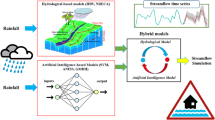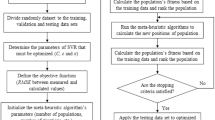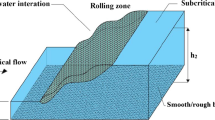Abstract
Saturated hydraulic conductivity (Ks) describes the water movement through saturated porous media. The hydraulic conductivity of streambed varies spatially owing to the variations in sediment distribution profiles all along the course of the stream. The artificial intelligence (AI) based spatial modeling schemes were instituted and tested to predict the spatial patterns of streambed hydraulic conductivity. The geographical coordinates (i.e., latitude and longitude) of the sampled locations from where the in situ hydraulic conductivity measurements were determined were used as model inputs to predict streambed Ks over spatial scale using artificial neural network (ANN), adaptive neuro-fuzzy inference system (ANFIS) and support vector machine (SVM) paradigms. The statistical measures computed by using the actual versus predicted streambed Ks values of individual models were comparatively evaluated. The AI-based spatial models provided superior spatial Ks prediction efficiencies with respect to both the strategies/schemes considered. The model efficiencies of spatial modeling scheme 1 (i.e., Strategy 1) were better compared to Strategy 2 due to the incorporation of more number of sampling points for model training. For instance, the SVM model with NSE = 0.941 (Strategy 1) and NSE = 0.895 (Strategy 2) were the best among all the models for 2016 data. Based on the scatter plots and Taylor diagrams plotted, the SVM model predictions were found to be much efficient even though, the ANFIS predictions were less biased. Although ANN and ANFIS models provided a satisfactory level of predictions, the SVM model provided virtuous streambed Ks patterns owing to its inherent capability to adapt to input data that are non-monotone and nonlinearly separable. The tuning of SVM parameters via 3D grid search was responsible for higher efficiencies of SVM models.



(adopted from Raghavendra and Deka 2014)








Similar content being viewed by others
References
Abraham A (2005) Adaptation of fuzzy inference system using neural learning. In: Nedjah N, Macedo Mourelle L (eds) Fuzzy systems engineering. Studies in fuzziness and soft computing, vol 181. Springer, Berlin, Heidelberg. https://doi.org/10.1007/11339366_3
Cortes C, Vapnik V (1995) Support-vector networks. Mach Learn 20:273–297. https://doi.org/10.1007/BF00994018
Cristianini N, Shawe-Taylor J (2000) An introduction to support vector machines and other kernel-based learning methods. Cambridge University Press, Cambridge
Cross SS, Harrison RF, Kennedy RL (1995) Introduction to neural networks. Lancet 346:1075–1079. https://doi.org/10.1016/S0140-6736(95)91746-2
Dai F, Zhou Q, Lv Z, Wang X, Liu G (2014) Spatial prediction of soil organic matter content integrating artificial neural network and ordinary kriging in Tibetan Plateau. Ecol Indic 45:184–194. https://doi.org/10.1016/j.ecolind.2014.04.003
Forkuor G, Hounkpatin OKL, Welp G, Thiel M (2017) High resolution mapping of soil properties using remote sensing variables in south-western Burkina Faso: a comparison of machine learning and multiple linear regression models. PLoS One 12:e0170478. https://doi.org/10.1371/journal.pone.0170478
Gholami V, Booij MJ, Nikzad Tehrani E, Hadian MA (2018) Spatial soil erosion estimation using an artificial neural network (ANN) and field plot data. Catena 163:210–218. https://doi.org/10.1016/j.catena.2017.12.027
Ghorbani H, Kashi H, Hafezi Moghadas N, Emamgholizadeh S (2015) Estimation of soil cation exchange capacity using multiple regression, artificial neural networks, and adaptive neuro-fuzzy inference system models in Golestan Province. Iran. Commun Soil Sci Plant Anal 46:763–780. https://doi.org/10.1080/00103624.2015.1006367
Grekousis G, Manetos P, Photis YN (2013) Modeling urban evolution using neural networks, fuzzy logic and GIS: the case of the Athens metropolitan area. Cities 30:193–203. https://doi.org/10.1016/j.cities.2012.03.006
Jain AK, Mao Jianchang, Mohiuddin KM (1996) Artificial neural networks: a tutorial. Computer (Long Beach Calif) 29:31–44. https://doi.org/10.1109/2.485891
Jang J-SR (1992) Neuro-fuzzy modeling: architectures, analyses, and applications. University of California, Berkeley
Jang JSR (1993) ANFIS: adaptive-network-based fuzzy inference system. IEEE Trans Syst Man Cybern 23:665–685. https://doi.org/10.1109/21.256541
Jang J-SR, Sun C-T, Mizutani E (1997) Neuro-fuzzy and soft computing: a computational approach to learning and machine intelligence. Prentice Hall, New Jersey
Khosravi K, Mao L, Kisi O, Yaseen ZM, Shahid S (2018) Quantifying hourly suspended sediment load using data mining models: case study of a glacierized Andean catchment in Chile. J Hydrol 567:165–179
Kirkwood C, Cave M, Beamish D, Grebby S, Ferreira A (2016) A machine learning approach to geochemical mapping. J Geochemical Explor. https://doi.org/10.1016/j.gexplo.2016.05.003
Kisi O, Yaseen ZM (2019) The potential of hybrid evolutionary fuzzy intelligence model for suspended sediment concentration prediction. Catena 174:11–23
Kohonen T (1988) An introduction to neural computing. Neural Networks 1:3–16. https://doi.org/10.1016/0893-6080(88)90020-2
Leuenberger M, Kanevski M (2015) Extreme learning machines for spatial environmental data. Comput Geosci 85:64–73. https://doi.org/10.1016/j.cageo.2015.06.020
Merdun H, Çınar Ö, Meral R, Apan M (2006) Comparison of artificial neural network and regression pedotransfer functions for prediction of soil water retention and saturated hydraulic conductivity. Soil Tillage Res 90:108–116. https://doi.org/10.1016/j.still.2005.08.011
More SB, Deka PC (2018) Estimation of saturated hydraulic conductivity using fuzzy neural network in a semi-arid basin scale for murum soils of India. ISH J Hydraul Eng 24:140–146. https://doi.org/10.1080/09715010.2017.1400408
Motaghian HR, Mohammadi J (2011) Spatial estimation of saturated hydraulic conductivity from terrain attributes using regression, kriging, and artificial neural networks. Pedosphere 21:170–177. https://doi.org/10.1016/S1002-0160(11)60115-X
Naganna SR, Deka PC (2018) Variability of streambed hydraulic conductivity in an intermittent stream reach regulated by Vented Dams: a case study. J Hydrol 562:477–491. https://doi.org/10.1016/j.jhydrol.2018.05.006
Naganna SR, Deka PC, Ch S, Hansen WF (2017) Factors influencing streambed hydraulic conductivity and their implications on stream–aquifer interaction: a conceptual review. Environ Sci Pollut Res 24:24765–24789. https://doi.org/10.1007/s11356-017-0393-4
Raghavendra NS, Deka PC (2014) Support vector machine applications in the field of hydrology: a review. Appl Soft Comput 19:372–386. https://doi.org/10.1016/j.asoc.2014.02.002
Reid CE, Jerrett M, Petersen ML, Pfister GG, Morefield PE, Tager IB, Raffuse SM, Balmes JR (2015) Spatiotemporal prediction of fine particulate matter during the 2008 Northern California wildfires using machine learning. Environ Sci Technol 49:3887–3896. https://doi.org/10.1021/es505846r
Sanikhani H, Deo RC, Yaseen ZM, Eray O, Kisi O (2018) Non-tuned data intelligent model for soil temperature estimation: a new approach. Geoderma 330:52–64
Sivanandam S, Paulraj M (2009) Introduction to artificial neural networks. Vikas Publishing House, New Delhi
Twarakavi NKC, Šimůnek J, Schaap MG (2009) Development of pedotransfer functions for estimation of soil hydraulic parameters using support vector machines. Soil Sci Soc Am J 73:1443. https://doi.org/10.2136/sssaj2008.0021
Vapnik VN (1999) An overview of statistical learning theory. IEEE Trans Neural Netw 10:988–999. https://doi.org/10.1109/72.788640
Vapnik VN (2000) The nature of statistical learning theory. Springer, New York. https://doi.org/10.1007/978-1-4757-3264-1
Wu G, Shu L, Lu C, Chen X (2015) The heterogeneity of 3-D vertical hydraulic conductivity in a streambed. Hydrol Res 47(1):15–26. https://doi.org/10.2166/nh.2015.224
Zhao C, Shao M, Jia X, Nasir M, Zhang C (2016) Using pedotransfer functions to estimate soil hydraulic conductivity in the Loess Plateau of China. Catena 143:1–6. https://doi.org/10.1016/j.catena.2016.03.037
Author information
Authors and Affiliations
Corresponding author
Ethics declarations
Conflict of interest
On behalf of all authors, the corresponding author states that there is no conflict of interest.
Rights and permissions
About this article
Cite this article
Naganna, S.R., Deka, P.C. Artificial intelligence approaches for spatial modeling of streambed hydraulic conductivity. Acta Geophys. 67, 891–903 (2019). https://doi.org/10.1007/s11600-019-00283-5
Received:
Accepted:
Published:
Issue Date:
DOI: https://doi.org/10.1007/s11600-019-00283-5




